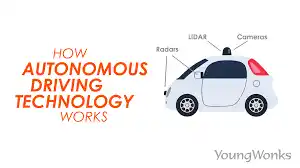How Do Self-Driving Cars Work

Self-driving cars have emerged as a captivating and transformative invention.
Combining artificial intelligence, sensors, and advanced computing, these vehicles have the potential to revolutionize the way we travel.
In this article, we’ll delve into the inner workings of self-driving cars, exploring the technology that powers them and the challenges they aim to overcome.
The Core Technology Behind Self-Driving Cars
1. Sensors and Perception
Self-driving cars are equipped with an array of sensors including LiDAR (Light Detection and Ranging), radar, cameras, and ultrasonic sensors. These sensors create a comprehensive view of the car’s surroundings, detecting objects, pedestrians, other vehicles, and road signs.
2. Mapping and Localization
These vehicles rely on detailed, high-definition maps that incorporate intricate information about the road, lane markings, traffic signals, and more. Coupled with GPS data, the car can accurately determine its location on the map, enabling it to navigate with precision.
3. Artificial Intelligence and Decision-Making
The heart of self-driving cars is sophisticated artificial intelligence (AI) software. This software processes the data from sensors, interprets the environment, and makes real-time decisions. It considers factors like traffic conditions, pedestrian behavior, and other vehicles to drive safely and efficiently.
4. Control and Actuation
The AI system communicates with the vehicle’s control systems to perform actions like steering, accelerating, and braking. By processing vast amounts of data and responding instantaneously, self-driving cars aim to navigate smoothly and make split-second decisions.
Overcoming Challenges
Despite their potential, self-driving cars face various challenges that need to be addressed for widespread adoption.
1. Safety Concerns
Safety is paramount, and self-driving cars must demonstrate reliability comparable to or exceeding human drivers. This includes handling unpredictable scenarios, adverse weather conditions, and technical malfunctions.
2. Legal and Regulatory Hurdles
The legal framework for self-driving cars varies across regions and poses a significant challenge. Governments and regulators need to adapt existing laws to accommodate autonomous vehicles and ensure liability standards are clear.
3. Ethical Decision-Making
Autonomous vehicles might face situations where ethical decisions must be made, such as choosing between minimizing harm to the car’s occupants or pedestrians. Developing a consensus on these decisions remains a complex task.
4. Human Interaction
Interactions between self-driving cars and human-driven vehicles, pedestrians, and cyclists can be intricate. Communicating the intentions of an autonomous vehicle and understanding human behaviour is crucial for safe coexistence.
FAQs
Are self-driving cars safe?
Self-driving cars are designed with safety in mind, equipped with advanced sensors and AI systems to navigate complex environments. However, challenges still exist, and the technology is continually being refined to ensure maximum safety.
How do self-driving cars navigate without human intervention?
Self-driving cars use a combination of high-definition maps, GPS, and real-time sensor data to accurately locate themselves and make decisions about navigation, all powered by complex AI algorithms.
What happens if a self-driving car encounters a scenario it doesn’t understand?
Self-driving cars are programmed to handle a wide range of scenarios, but if they encounter something unfamiliar, they are designed to follow predefined protocols, prioritize safety, and request human intervention in some cases.
When can we expect to see fully autonomous vehicles on the roads?
The timeline for fully autonomous vehicles varies and is influenced by technological advancements, regulatory approvals, and societal acceptance. While some self-driving features are already available in certain vehicles, widespread adoption of fully autonomous cars may take several years.
Also Read: Various Types of Biometric Authentication Methods





